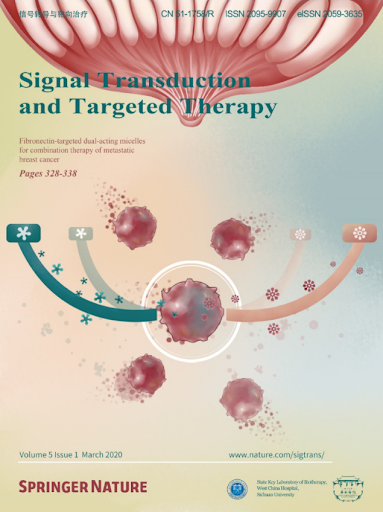肿瘤微环境描述了her2阳性转移性乳腺癌患者对曲妥珠单抗emtansine的差异反应:一项II期研究(NJMU-BC02)的探索性生物标志物分析。
IF 52.7
1区 医学
Q1 BIOCHEMISTRY & MOLECULAR BIOLOGY
引用次数: 0
摘要
曲妥珠单抗emtansine (T-DM1)已被批准用于治疗her2阳性乳腺癌。然而,T-DM1在吡罗替尼和/或曲妥珠单抗加帕妥珠单抗治疗失败后的疗效尚不清楚。此外,没有生物标志物被报道预测T-DM1的作用。在这个多中心II期试验(NCT06125834)中,36名her2阳性转移性乳腺癌患者入组接受T-DM1治疗,周期21天,直到进展或不可接受的毒性。主要终点为客观缓解率(ORR)。次要终点包括疾病控制率(DCR)、临床获益率(CBR)、无进展生存期(PFS)和毒性。主要终点ORR为47.2% (17/36,95% CI 30.4-64.5)。治疗表现出可控的毒性。DCR为66.7% (24/36,95% CI 49.0 ~ 81.4), CBR为50.0% (18/36,95% CI 32.9 ~ 67.1)。中位PFS为6.6个月(95% CI 5.2-NA)。单细胞RNA测序显示,癌细胞、活化的巨噬细胞和CD8+ T细胞的低细胞周期活性与T- dm1的良好疗效有关,这在新辅助队列中得到了验证。该研究表明,T-DM1在罗替尼和/或曲妥珠单抗加帕妥珠单抗治疗失败后转移性her2阳性乳腺癌患者中是有效的,具有可测量的安全性。我们的初步研究结果表明,潜在的生物标志物可能有助于预测T-DM1的疗效,为可能解决T-DM1耐药性的新治疗靶点提供假设。本文章由计算机程序翻译,如有差异,请以英文原文为准。
Tumor microenvironment delineates differential responders to trastuzumab emtansine in HER2-positive metastatic breast cancer patients previously treated with pyrotinib: an exploratory biomarker analysis of a phase II study (NJMU-BC02).
Trastuzumab emtansine (T-DM1) has been approved for the treatment of HER2-positive breast cancer. However, the efficacy of T-DM1 for patients after failure of pyrotinib and/or trastuzumab plus pertuzumab has not been clear. Additionally, no biomarker has been reported to predict the effect of T-DM1. In this multicenter phase II trial (NCT06125834), 36 participants with HER2-positive metastatic breast cancer were enrolled to receive T-DM1 therapy on a 21-day cycle until progression or unacceptable toxicity. The primary endpoint was the objective response rate (ORR). The secondary endpoints included the disease control rate (DCR), clinical benefit rate (CBR), progression-free survival (PFS), and toxicity. The primary endpoint was an ORR of 47.2% (17/36, 95% CI 30.4-64.5). The treatment exhibited a manageable toxicity profile. The DCR was 66.7% (24/36, 95% CI 49.0-81.4), and the CBR was 50.0% (18/36, 95% CI 32.9-67.1). The median PFS was 6.6 (95% CI 5.2-NA) months. Single-cell RNA sequencing revealed that the low cell cycle activity of cancer cells, activated macrophages and CD8+ T cells was associated with the good efficacy of T-DM1, which was validated in a neoadjuvant cohort. This study suggests that T-DM1 is effective with a measurable safety profile in patients with metastatic HER2-positive breast cancer after failure of pyrotinib and/or trastuzumab plus pertuzumab. Our preliminary findings suggest potential biomarkers that may help predict T-DM1 efficacy, generating hypotheses for novel therapeutic targets that may address T-DM1 resistance.
求助全文
通过发布文献求助,成功后即可免费获取论文全文。
去求助
来源期刊

Signal Transduction and Targeted Therapy
Biochemistry, Genetics and Molecular Biology-Genetics
CiteScore
44.50
自引率
1.50%
发文量
384
审稿时长
5 weeks
期刊介绍:
Signal Transduction and Targeted Therapy is an open access journal that focuses on timely publication of cutting-edge discoveries and advancements in basic science and clinical research related to signal transduction and targeted therapy.
Scope: The journal covers research on major human diseases, including, but not limited to:
Cancer,Cardiovascular diseases,Autoimmune diseases,Nervous system diseases.
 求助内容:
求助内容: 应助结果提醒方式:
应助结果提醒方式:


